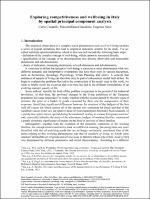Chapter Exploring competitiveness and wellbeing in Italy by spatial principal component analysis
Author(s)
Cusatelli, Carlo
Giacalone, Massimiliano
Nissi, Eugenia
Language
EnglishAbstract
Well being is a multidimensional phenomenon, that cannot be measured by a single descriptive indicator and that, it should be represented by multiple dimensions. It requires, to be measured by combination of different dimensions that can be considered together as components of the phenomenon. This combination can be obtained by applying methodologies knows as Composite Indicators (CIs). CIs are largely used to have a comprehensive view on a phenomenon that cannot be captured by a single indicator. Principal Component Analysis (PCA) is one of the most popular multivariate statistical technique used for reducing data with many dimension, and often well being indicators are obtained using PCA. PCA is implicitly based on a reflective measurement model that it non suitable for all types of indicators. Mazziotta and Pareto (2013) in their paper discuss the use and misuse of PCA for measuring well-being. The classical PCA is not suitable for data collected on the territory because it does not take into account the spatial autocorrelation present in the data. The aim of this paper is to propose the use of Spatial Principal Component Analysis for measuring well being in the Italian Provinces.
Keywords
Well being; Spatial Principal Component Analysis (sPCA); Composite IndicatorsDOI
10.36253/978-88-5518-461-8.27ISBN
9788855184618, 9788855184618Publisher
Firenze University PressPublisher website
https://www.fupress.com/Publication date and place
Florence, 2021Series
Proceedings e report, 132Classification
Social research and statistics


 Download
Download Web Shop
Web Shop